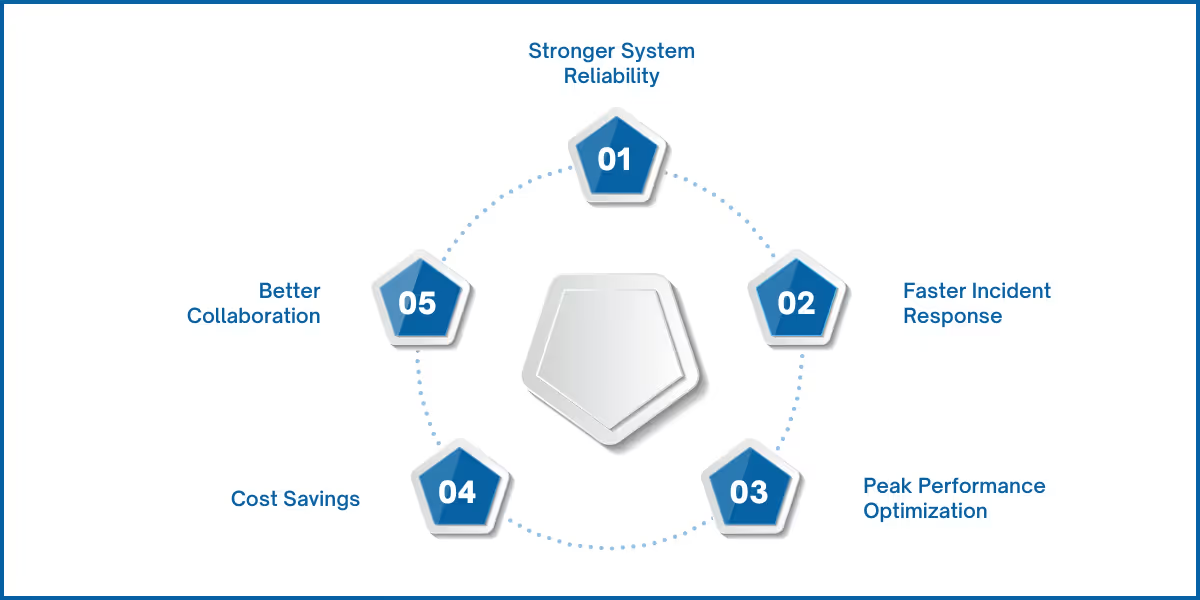

No company is immune to costly disruptions like outages and downtimes, regardless of its size or influence. Even a brief outage can lead to significant financial and reputational damage. Meta’s 2024 outage, which resulted in nearly $100 million in lost revenue, serves as a clear reminder of how vital system reliability is for business success.
Imagine a world where your systems never fail, your users never experience downtime, and your teams can focus on innovation without firefighting operational issues. Sounds ideal, right? While achieving perfection may not be realistic, Site Reliability Engineering (SRE) brings us quite closer.
Keeping digital systems running smoothly is no small feat. With businesses relying more than ever on technology, ensuring reliability and scalability has become a top priority. This is where Site Reliability Engineering (SRE) comes in. Introduced by Google, it merges software development with IT operations to create a structured approach to maintain system stability and performance.
By automating repetitive tasks, monitoring critical processes, and proactively addressing potential issues, organizations can keep their services running without interruptions. At its core, SRE is about preventing problems before they escalate.
Unplanned system failures can have far-reaching consequences, impacting revenue, brand reputation, and customer trust. Studies indicate that one in six outages costs businesses over $1 million, highlighting the growing need for operational reliability. Industries such as healthcare and finance, where uninterrupted service is crucial, face even higher stakes when disruptions occur.
Implementing Site Reliability Engineering (SRE) allows businesses to mitigate risks by addressing vulnerabilities like software bugs, misconfigurations, and traffic surges before they affect operations. By enhancing system resilience and optimizing performance, SRE ensures consistent service delivery and prepares businesses for future challenges.
While the roles of SRE and DevOps may overlap in some organizations, each brings unique strengths to the table. Both focus on improving software delivery and system reliability, but they address different stages of the software lifecycle.
The table below highlights the key differences between these two approaches to provide a clearer understanding of their distinct contributions.
FeatureSREDevOpsFocusReliability and performanceSpeed and collaborationKey ResponsibilitiesPost-deployment operations, monitoring, scalingDevelopment, testing, deployment automationGoalMinimize downtime, optimize capacityAccelerate development cyclesApproachProactive incident managementContinuous integration and delivery
Do businesses need both? Absolutely. DevOps accelerates software development, while SRE ensures what gets deployed remains stable and performs optimally. Together, they create a robust framework for delivering reliable, high-quality services.
But does SRE guarantee zero outages? Not exactly. No system is completely immune to failures, but SRE significantly reduces their frequency and impact by fostering a culture of proactive problem-solving and continuous improvement. By combining both approaches, businesses can achieve rapid innovation without sacrificing reliability.

Implementing SRE helps businesses build a foundation for long-term operational success. By focusing on reliability, efficiency, and collaboration, organizations can prevent costly downtime and ensure a seamless user experience. Prioritizing reliability allows businesses to scale and adapt to evolving demands without compromising performance.
Here’s how adopting SRE practices makes a real difference:
Recognizing these benefits helps organizations embrace SRE principles and implement them effectively to build resilient, high-performing systems.

Site Reliability Engineering is based on core ideas that guide teams in maintaining system stability and efficiency. Here are the principles that serve as the foundation for SRE practices:
Ensuring system reliability is the top priority. It refers to a system's ability to function without interruptions, even under challenging conditions. SRE prioritizes reliability over feature development or performance enhancements to maintain uninterrupted service delivery.
SRE fosters a culture of collaboration between development and operations, making reliability a collective responsibility. Engineers work alongside developers to integrate reliability considerations from the design stage, ensuring systems are built with resilience in mind.
Automating repetitive tasks, such as infrastructure provisioning, software deployments, and system monitoring, helps reduce manual effort and human error. This allows engineers to focus on strategic improvements rather than routine operations.
Detailed monitoring and measurement are essential for identifying anomalies and improving system performance. SRE teams rely on real-time data to make informed decisions, detect issues early, and implement timely resolutions using robust alerting systems.
SRE teams are equipped with structured processes to handle incidents efficiently. They follow predefined escalation protocols and conduct postmortems to analyze root causes and implement preventive measures, fostering a culture of continuous learning.
To ensure systems can handle varying traffic loads, SRE focuses on forecasting demand and scaling resources accordingly. Load balancing strategies are used to distribute traffic efficiently, preventing performance bottlenecks.
SRE embraces a mindset of ongoing enhancement by gathering feedback, analyzing performance data, and refining processes. Regular system evaluations and blameless postmortems drive incremental improvements and long-term reliability.
These principles form the backbone of SRE, empowering organizations to create resilient and scalable systems that meet user expectations. To measure the effectiveness of these principles and ensure reliability goals are met, it's essential to focus on the right metrics—key indicators that bridge the gap between theory and practical success.
Chasing perfect system reliability might sound ideal, but it can hold back innovation and slow progress. Instead of aiming for 100% uptime, businesses should adopt a balanced approach that keeps systems stable while supporting growth.
To put this approach into practice, SRE teams rely on the following key metrics to measure and maintain service quality and reliability:
Tracking metrics is one aspect of an SRE team’s role. Their responsibilities also include ensuring that systems remain efficient, reliable, and scalable.
An SRE team plays a pivotal role in ensuring system reliability and performance by taking ownership of several critical areas mentioned below:
While the role and responsibilities of an SRE team are crucial to maintaining system reliability, the question remains: why should organizations adopt SRE in the first place? Understanding the benefits of this approach can help businesses make informed decisions about its implementation.
Regardless of industry or size, adopting SRE practices helps businesses build reliable, scalable, and efficient systems. SRE enhances operational stability while driving long-term growth and success. Key Advantages of SRE Implementation to businesses include the following:
Downtime can result in financial losses and reputational damage. SRE ensures high availability through proactive monitoring, fault tolerance, and disaster recovery strategies, minimizing disruptions and maintaining service consistency.
Growing businesses need systems that can handle increasing demands. SRE helps design scalable architectures and optimize performance to accommodate traffic surges and future growth.
Manual processes can be costly and time-consuming. SRE promotes automation and resource optimization to improve efficiency and eliminate unnecessary manual tasks.
SRE fosters a culture of shared responsibility between development and operations, improving collaboration through knowledge sharing and post-incident reviews.
Building secure systems is critical. SRE integrates security best practices into development processes, implementing monitoring and auditing to mitigate risks and ensure compliance.
By adopting SRE, businesses can achieve operational excellence, scale effectively, and deliver a seamless user experience. Once the need for SRE is recognized, the next step is understanding how to implement it effectively.
Implementing Site Reliability Engineering requires a structured approach that aligns with business goals while fostering a culture of reliability and continuous improvement. Here’s how to build a successful SRE function:
Identify critical system components and define Service Level Objectives (SLOs) that align with business needs. Collaborate with stakeholders to establish acceptable performance thresholds and prioritize reliability without stifling innovation.
Hire or upskill engineers with expertise in software development, operations, and automation. Encourage cross-functional collaboration to bridge knowledge gaps and ensure shared ownership of reliability goals.
Use tools like Prometheus, Grafana, and Datadog to track key performance indicators and detect issues early. Effective observability, including metrics, logs, and traces, provides actionable insights for improving system reliability.
Leverage Infrastructure as Code (IaC) tools such as Terraform and Ansible to automate deployments, scaling, and configuration management. Automation not only reduces human error but also enhances overall performance.
Create playbooks with clear escalation paths and roles to ensure swift and effective incident resolution. Regular incident simulations or “game days” help teams refine their response strategies.
Encourage a blameless postmortem culture to analyze incidents, identify root causes, and continuously improve processes. Regular reviews and documentation updates help refine reliability practices over time.
Regularly assess SRE metrics against business objectives to demonstrate the value of reliability initiatives. Effective communication with stakeholders helps prioritize investments in system resilience.
By following these steps, organizations can lay a solid foundation for SRE, ensuring resilient, scalable, and efficient systems that support long-term growth.
System failures are rarely the result of individual mistakes; they often stem from underlying process inefficiencies. Instead of assigning blame, organizations that embrace a culture of learning and continuous improvement can address these gaps more effectively. SRE provides a structured approach to identifying weak points, refining processes, and enhancing system reliability while maintaining a steady pace of innovation.
Partnering with WaferWire ensures your systems are built with reliability at their core. Through proactive management, resilience testing, and automated scaling, you can maintain consistent performance and adapt to evolving workloads with ease.
Disruptions in IT operations, such as system outages, performance bottlenecks, and unexpected failures, can lead to downtime, revenue loss, and a poor user experience. By proactively identifying risks and optimizing infrastructure, WaferWire’s SRE solutions help businesses maintain seamless operations, ensuring stability while staying agile and competitive in a dynamic market.
With a focus on minimizing disruptions like outages and optimizing infrastructure, WaferWire’s SRE solutions empower businesses to achieve operational excellence while staying agile and competitive in the business world.
Looking to achieve exceptional uptime and faster incident resolution for seamless service availability, even during peak demand? Contact us today and let us help you build a future-ready foundation.

